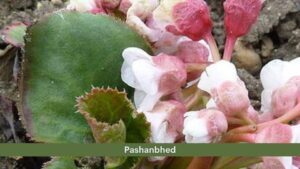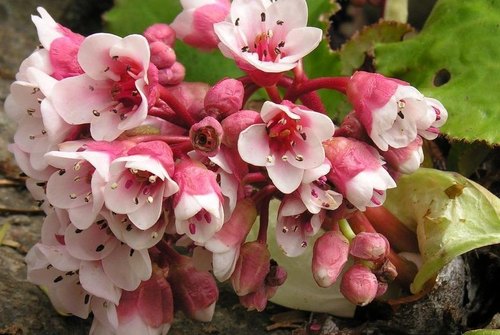Ayurvedic
Pashanbheda (Bergenia ligulata) Herb Ayurvedic Overview
Pashanbheda (Bergenia ligulata), the literal meaning of word Pashanbheda breaks stone (Pashan is stone and bheda means to break, in Sanskrit). It is a succulent perennial herb that reaches a height up to 50 cm. It is distributed in the temperate Himalaya (from Kashmir to Nepal) from 2,000 – 2,700 m and is found very common in Central and East Asia, Pakistan.
The leaves of pashanbheda are ovate or round and 5-15 cm long at flowering time. The upper & lower surface is hairy, becoming almost hairless in age. The flowers are white, pink, or purple having 3.2 cm in diameter, forming a cymose panicle with a flexible flowering stem.
Different Ayurvedic Acharyas mentioned this plant and recommended its uses for the management of urinary stones. Charak Samhita recommended it for painful micturition, breaking up calculi, and abdominal tumors. The plant is rich in various medicinal properties like Diuretic activity, Antiurolithic activity, Antipyretic activity, Hepatoprotective activity, Anti-diabetic activity, etc.
Table of Contents
Scientific Classification of Pashanbheda (Bergenia ligulata):
- Kingdom: Plantae- Plants
- Subkingdom: Tracheobionta-Vascular plants
- Superdivison: Spermatophyta- Seed plants
- Division: Magnoliphyta- Floweringp lants
- Class: Magnoliopsida- Dicotyledons
- Subclass: Rosidae
- Order: Rosales
- Family: Saxifragaceae- Saxifrage family
- Genus: Bergenia Moench- elephant ear
- Species: Bergenia ligulata (Wall.)
Pashanbheda (Bergenia ligulata) Synonyms:
- Sanskrit: Silabheda, Asmabhedaka
- Assamese: Patharkuchi
- Bengali: Patharkuchi, Himasagara, Patrankur
- Gujrati: Pashanbheda, Pakhanbheda
- Hindi: Pakhanabheda, Silphara, Patharcua, Pakhanabhed, Silpbheda
- Kannada: Alepgaya, Pahanbhedi, Hittaga, Pasanaberu, Hittulaka
- Kashmiri: Pashanbhed
- Malayalam: Kallurvanchi, Kallurvanni, Kallorvanchi
- Marathi: Pashanbheda
- Oriya: Pasanbhedi, Pashanabheda
- Punjabi: Kachalu, Pashanbhed
- Tamil: Sirupilai
- Telugu: Kondapindi
Pashanbheda (Bergenia ligulata) Description:
 Macroscopic: The rhizome of pashanbheda is solid, barrel-shaped, cylindrical, 1.5-3 cm long, and 1-2 cm in diameter having small roots. The transversely cut surface shows an outer ring of brown-colored cork. The middle cortex is short having vascular bundles and a large central pith.
Macroscopic: The rhizome of pashanbheda is solid, barrel-shaped, cylindrical, 1.5-3 cm long, and 1-2 cm in diameter having small roots. The transversely cut surface shows an outer ring of brown-colored cork. The middle cortex is short having vascular bundles and a large central pith.
Microscopic: The transverse section of the rhizome has a cork that is divided into two zones, the outer having a few layers of slightly compressed and brown cells and the inner zone is multilayered consisting of thin-walled tangentially elongated and colorless followed by a single-layered cork cambium and 2-3 layers of secondary cortex composed of thin-walled, elongated, and rectangular cells with intercellular spaces. Some cells contain rosette crystals of calcium oxalate and simple starch grains. Most of the cortical cells contain large rosette crystals of calcium oxalate.
The vascular bundles are arranged in a ring, collateral, conjoint and open. The phloem tissues are composed of sieve elements and parenchyma. The outer region is compressed of masses while in the inner region several rosette crystals of calcium oxalate are found. The cambium presents as a continuous ring composed of 2-3 layers of thin-walled, tangentially elongated cells. The xylem consists of fibers, tracheids, vessels, and parenchyma with a center occupied by a large pith composed of circular to oval parenchymatous cells varying in size and containing starch grains with crystals of calcium oxalate similar to those found in the cortical region.
Identity, Purity, and Strength of Pashanbheda (Bergenia ligulata):
- Foreign matter Not more than 2 percent, Appendix 2.2.2.
- Total Ash Not more than 13 percent, Appendix 2.2.3.
- Acid-insoluble ash Not more than 0.5 percent, Appendix 2.2.4.
- Alcohol-soluble extractive Not less than 9 percent, Appendix 2.2.6.
- Water-soluble extractive Not less than 15 percent, Appendix 2.2.7.
Chemical Constituents of Pashanbheda (Bergenia ligulata):
The rhizome of the plant Bergenia lingulata is rich in gallic acid, starch, glucose, bergenin, tannins, mucilage, and wax.
Ayurvedic Properties and Action of Pashanbheda (Bergenia ligulata):
- Rasa (taste): Tikta, Kashaya
- Guna (quality): Laghu
- Virya (potency): Sheeta
- Vipaka (taste conversion after digestion): Katu
- Karma: Mutravirechniya, Ashmarighana, Bhedana, Vastishodhana
Classical Categorization of Pashanbheda (Bergenia ligulata):
- Sushruta: Viratarvadi
- Vagbhata: Viratarvadi
- Bhavaprakasha: Haritakyadi Varga
- Charaka: Mutravirchniya
- Raja Nighantu: Parpatadi Varga
- Kaiyyadeva Nighantu: Oushadi Varga
- Dhanwantari Nighantu: Guduchyadi Varga
Ayurvedic Formulations made by Pashanbheda (Bergenia ligulata):
The important formulations are Ashmarihara Kashaya, Vastyamayantaka Ghrita, Mootravirechaniya Kashaya.
Therapeutic Uses of Pashanbheda (Bergenia ligulata):
Therapeutic Uses are Bastishodhana, Gulma, Arsha, Mutrakricha, Prameha, Shoola, Vrana, Pleeha, Ashmari.
Dose of Pashanbheda (Bergenia ligulata):
- 3-6 gm of the drug in powder form.
- 20-30 gm of the drug for decoction.
Reference:
Ayurvedic Pharmacopoeia of India.
For regular health updates, Please follow our Social Pages


